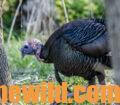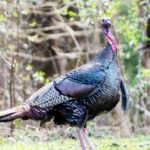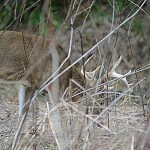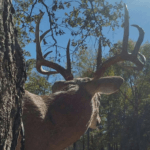Editor’s Note: One of the nation’s leading turkey callers and hunters for four decades, Chris Parrish of Centralia, Missouri, has won 10 World Turkey Calling Championships and 11 Grand National Turkey Calling Championships. Parrish spends thousands of hours in the woods before, during and after turkey season listening to, observing and taking notes on the social behavior of turkeys. As a longtime student of the wild turkey gobbler, Parrish shares 12 secrets this week to help you take more gobblers this season.
 9) Take turkeys With a Wingbone Call: To take turkeys on a hunting club, use a call the turkeys rarely hear. Most people don’t think the wingbone call sounds very much like a turkey. But when you stand 20-30 yards away, you’ll see it does sound like a turkey. I’ve called in plenty of gobblers using the wingbone call, which does present a little more challenge to use than other calls do. Few hunters learn to use the wingbone call. For this reason, the wingbone call can become one of the most- deadly turkey calls any hunter can use on any hunting club because the turkeys seldom hear it.
9) Take turkeys With a Wingbone Call: To take turkeys on a hunting club, use a call the turkeys rarely hear. Most people don’t think the wingbone call sounds very much like a turkey. But when you stand 20-30 yards away, you’ll see it does sound like a turkey. I’ve called in plenty of gobblers using the wingbone call, which does present a little more challenge to use than other calls do. Few hunters learn to use the wingbone call. For this reason, the wingbone call can become one of the most- deadly turkey calls any hunter can use on any hunting club because the turkeys seldom hear it.

10) Use Other Calls: Turkeys make many-different sounds, other than vocal, when in the woods. Often these sounds will call a turkey in quicker and easier than the calling sounds do. For instance, turkeys make sounds with their wings, including dragging their wings in the leaves when they strut. And, when hens feed, they’ll flap their wings to stretch them. I’ve used a turkey wing to call-in a turkey I haven’t been able to call to successfully with conventional turkey calls. Feeding turkeys also scratch in the leaves, a sound that also can lure in a hung-up gobbler or a gobbler that needs a little extra coaxing.
11) Use Gobbler Calls: Many hunters reluctantly use gobbler calls in the spring of the year. However, the kee-kee run and the fighting purr often will bring-in a tough, old longbeard. I rely on these two calls as my last resort to bring in a gobbler that won’t come in to any other type of calling I do. Usually when you use jake calling or fighting-purr calling, you’ll either bring the gobbler to you, or you’ll run him off. Then you can reposition and try other calls on him.
 12) Know When and How to Use Decoys: Some calls work best when you hunt with decoys. (Be sure to check your state’s regulations for using turkey decoys). I only use decoys when hunting on the edges of open fields, along power lines or on wood roads. On a hunting club, you may want to limit the use of decoys to only these types of areas or certain other sections of your club to keep the turkeys from becoming decoy-shy. Consider using decoys only in fields, on roadways or only during the last week of the season. This rule will increase the hunters’ chances of taking turkeys with the use of decoys. Remember when you set-out decoys, to never sit directly behind a decoy. Hunt defensively. Always have a tree wider than your shoulders at your back when using a decoy. When you pick-up your decoys, make sure you wear hunter orange.
12) Know When and How to Use Decoys: Some calls work best when you hunt with decoys. (Be sure to check your state’s regulations for using turkey decoys). I only use decoys when hunting on the edges of open fields, along power lines or on wood roads. On a hunting club, you may want to limit the use of decoys to only these types of areas or certain other sections of your club to keep the turkeys from becoming decoy-shy. Consider using decoys only in fields, on roadways or only during the last week of the season. This rule will increase the hunters’ chances of taking turkeys with the use of decoys. Remember when you set-out decoys, to never sit directly behind a decoy. Hunt defensively. Always have a tree wider than your shoulders at your back when using a decoy. When you pick-up your decoys, make sure you wear hunter orange.
These techniques will make hunting turkeys in the spring much more effective and enjoyable for you. The less hunting pressure the birds experience, the greater your chances for taking a bird.
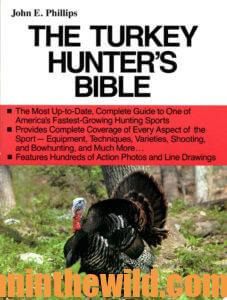 To learn more about hunting turkeys successfully, visit John E. Phillips’ Amazon book page at https://www.amazon.com/John-E.-Phillips/e/B001HP7K6O. For even more information from many of the top turkey hunters and callers, go to the book, “Turkey Hunters’ Bible,” https://www.amazon.com/gp/product/B007HT1IUS/ref=dbs_a_def_rwt_hsch_vapi_taft_p2_i7 available in Kindle, print and Audible. You may have to copy and paste this link into your browser. (When you click on the book, notice on the left where Amazon says you can read and hear 10% of the book for free). On the right side of the page and below the offer for a free Audible trial, you can click on Buy the Audible book.
To learn more about hunting turkeys successfully, visit John E. Phillips’ Amazon book page at https://www.amazon.com/John-E.-Phillips/e/B001HP7K6O. For even more information from many of the top turkey hunters and callers, go to the book, “Turkey Hunters’ Bible,” https://www.amazon.com/gp/product/B007HT1IUS/ref=dbs_a_def_rwt_hsch_vapi_taft_p2_i7 available in Kindle, print and Audible. You may have to copy and paste this link into your browser. (When you click on the book, notice on the left where Amazon says you can read and hear 10% of the book for free). On the right side of the page and below the offer for a free Audible trial, you can click on Buy the Audible book.

